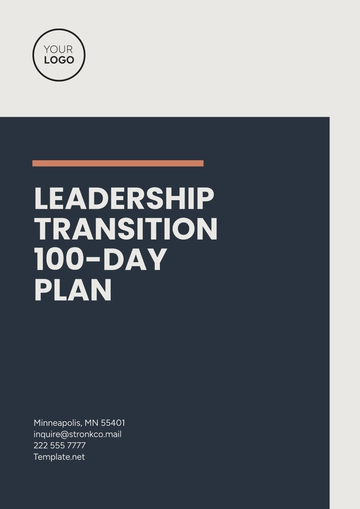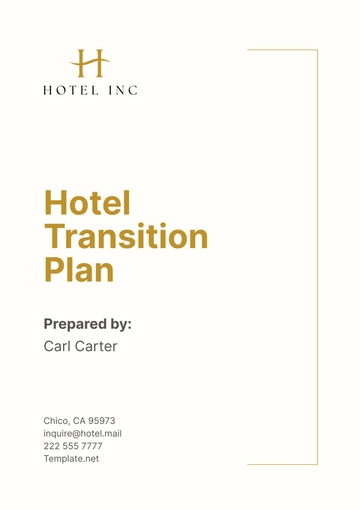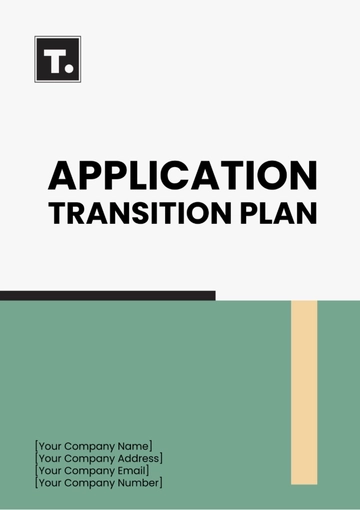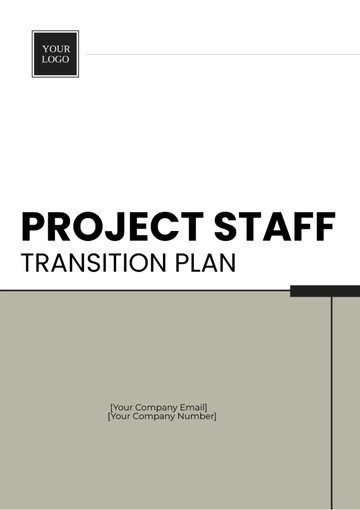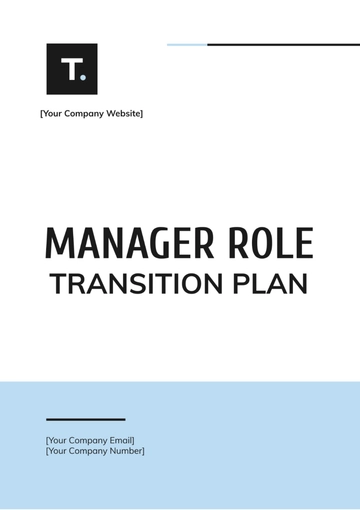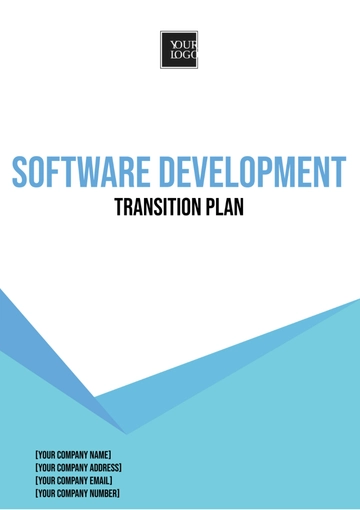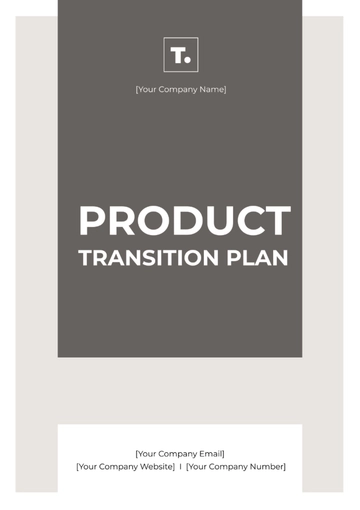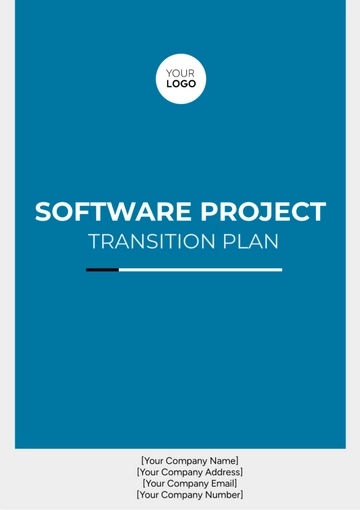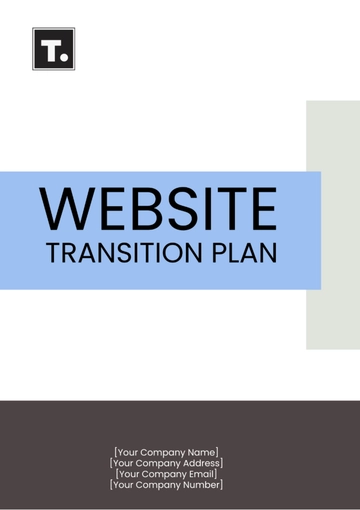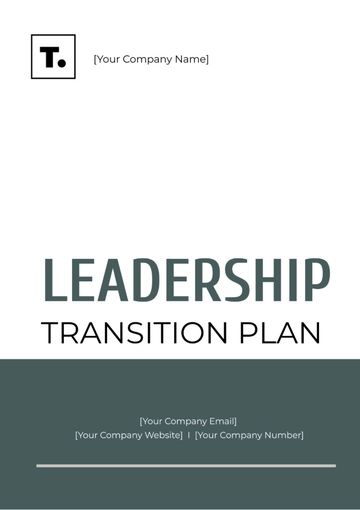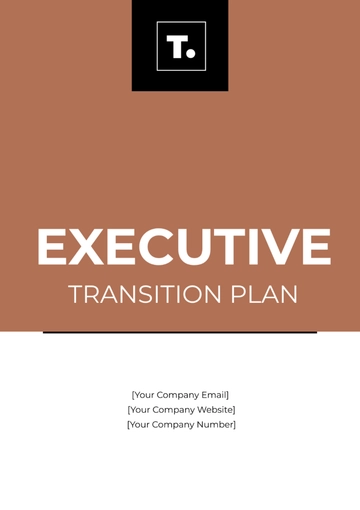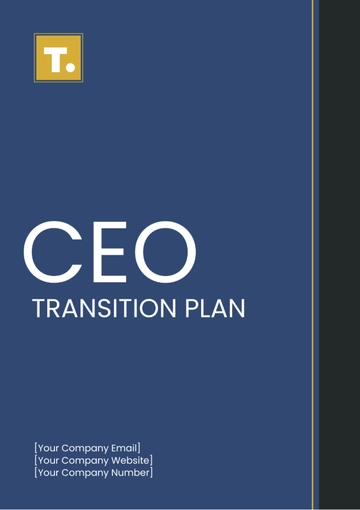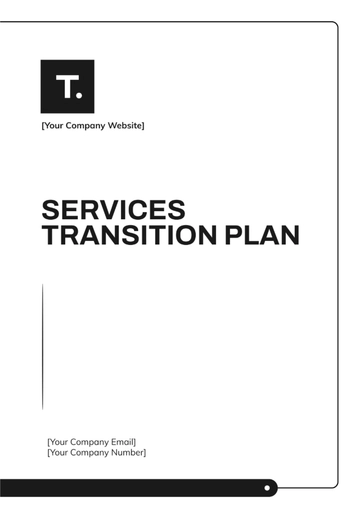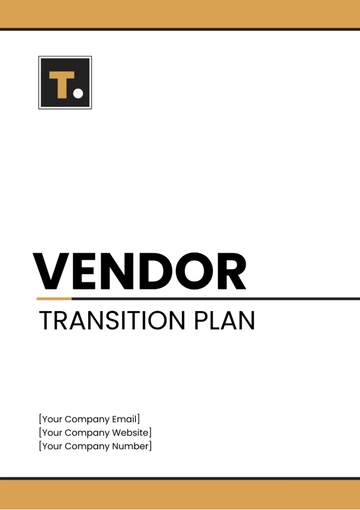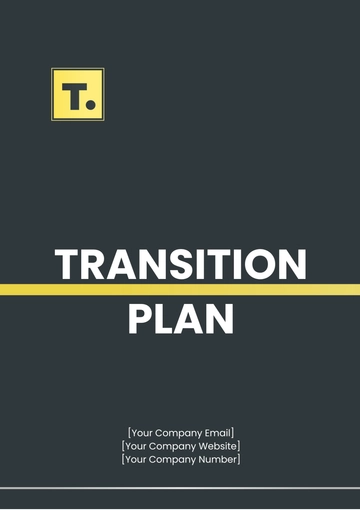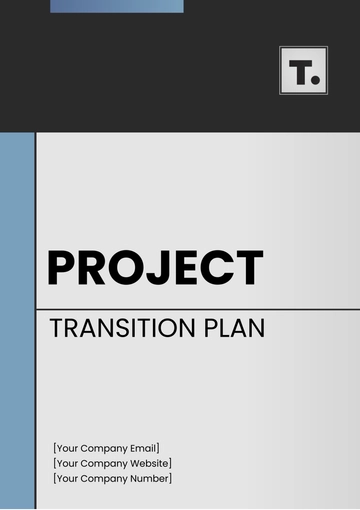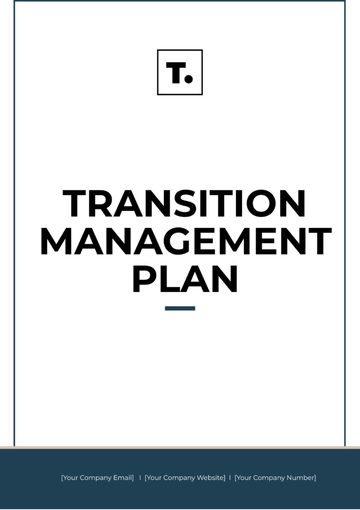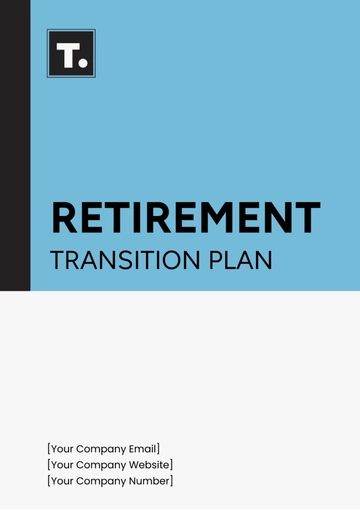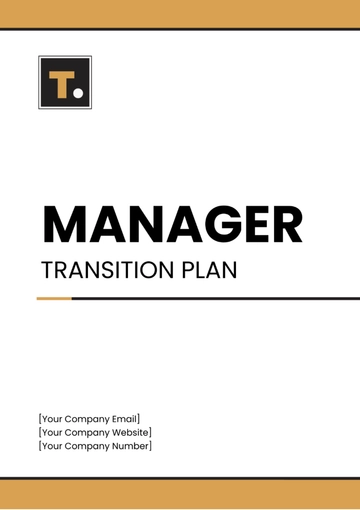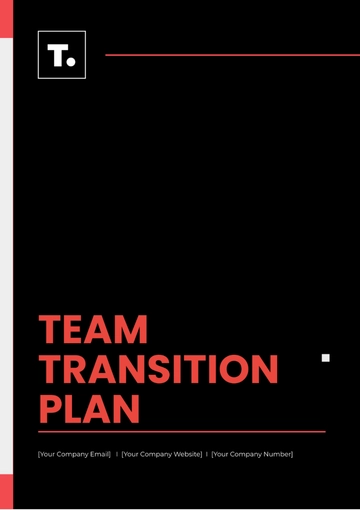Free Cleaning Services Leadership Transition Plan
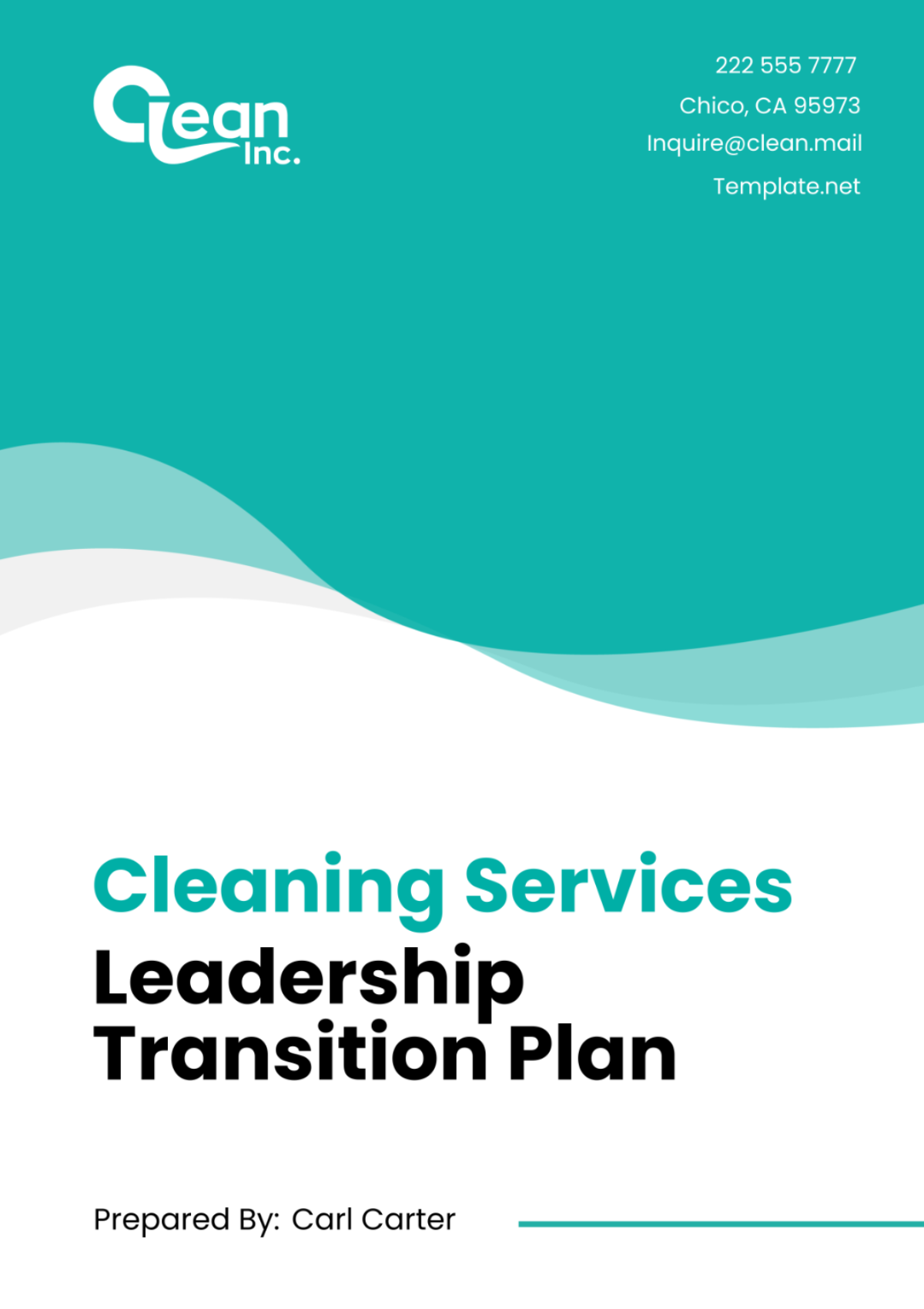
I. Introduction
Transitioning leadership within [Your Company Name] is a critical process to ensure continuity, maintain service quality, and sustain client satisfaction. This transition plan outlines our strategy for a seamless transfer of leadership responsibilities.
II. Identification of Key Stakeholders
By recognizing and engaging with these key stakeholders throughout the transition process, [Your Company Name] can ensure a comprehensive and inclusive approach to leadership change that minimizes disruptions and maximizes stakeholder buy-in and support. Key stakeholders involved in the leadership transition include:
Current Leadership Team: This encompasses the outgoing leaders who are transitioning out of their roles. Their cooperation, knowledge, and experience are invaluable in facilitating a seamless handover process.
Incoming Leadership: The individuals slated to assume leadership roles within the company. It's imperative to involve them in the transition process early on to familiarize them with the organization's culture, processes, and strategic objectives.
Employees at All Levels: Every member of the organization, from frontline staff to middle management, is affected by leadership transitions. Engaging and communicating with employees throughout the process is essential for maintaining morale, productivity, and a sense of stability.
Clients and Customers: Clients rely on [Your Company Name] for consistent and reliable cleaning solutions. Transparent communication with clients regarding the leadership transition is vital to reassure them of continued service quality and to address any concerns they may have.
Vendors and Suppliers: External partners, including vendors and suppliers, may be impacted by leadership changes, particularly if there are alterations to procurement processes or contractual agreements. Maintaining positive relationships with these stakeholders is essential for uninterrupted service delivery.
Regulatory Bodies and Compliance Agencies: Depending on the industry and geographical location, regulatory bodies and compliance agencies may need to be informed about changes in leadership, especially if there are licensing or accreditation requirements involved.
Investors and Shareholders (if applicable): For companies with investors or shareholders, keeping them informed about leadership transitions is crucial for maintaining trust and confidence in the organization's stability and long-term prospects.
Community and Public Perception: The local community and the public at large may also have an interest in leadership changes within [Your Company Name], particularly if the company plays a significant role in the community or if there are public relations implications.
III. Succession Planning
Succession planning is a proactive strategy implemented by [Your Company Name] to identify and develop internal talent to fill key leadership roles, ensuring organizational continuity and sustainability. This comprehensive succession planning process involves the following components:
Talent Identification and Development: [Your Company Name] systematically identifies high-potential employees who demonstrate the skills, capabilities, and leadership qualities necessary to assume leadership positions in the future. This identification process includes performance evaluations, skills assessments, and leadership potential assessments.
Leadership Development Programs: Once high-potential employees are identified, [Your Company Name] invests in their professional development through targeted training programs, mentorship opportunities, and leadership workshops. These programs aim to enhance their leadership competencies, strategic thinking abilities, and decision-making skills, preparing them for future leadership roles within the organization.
Succession Pipeline Creation: By fostering a culture of talent development and internal promotion, [Your Company Name] creates a robust succession pipeline that ensures a steady supply of qualified candidates for key leadership positions. This pipeline allows the organization to fill vacancies promptly and efficiently, minimizing disruptions to operations.
Cross-Training and Job Rotation: To broaden employees' skill sets and expose them to diverse aspects of the business, [Your Company Name] facilitates cross-training initiatives and job rotation programs. These initiatives enable employees to gain valuable experience in different departments or roles, preparing them for leadership positions that require a comprehensive understanding of the organization's operations.
Performance Management and Feedback: [Your Company Name] maintains a structured performance management system that provides regular feedback and coaching to employees, helping them understand their strengths, areas for improvement, and career development opportunities. Clear performance expectations and developmental goals are established to align individual aspirations with organizational objectives.
Contingency Planning: In addition to developing a pipeline of internal talent, [Your Company Name] also prepares contingency plans for unforeseen circumstances, such as sudden departures or emergencies involving key leaders. These plans outline alternative staffing strategies and interim leadership arrangements to mitigate risks and ensure business continuity.
Executive Coaching and Mentoring: Senior leaders within [Your Company Name] serve as mentors and coaches to emerging leaders, providing guidance, support, and insights based on their own experiences. These mentoring relationships foster professional growth, leadership development, and succession readiness among future leaders.
IV. Timeline and Milestones
This timeline outlines the key activities and milestones involved in the leadership transition process over a seven-month period, ensuring a structured and systematic approach to the transition.
Month | Activity | Milestones |
|---|---|---|
Month 1 | Announcement of leadership transition | Formal announcement to all employees |
Introduction of incoming leadership | ||
Communication plan rollout | ||
Month 2-3 | Transition planning and knowledge transfer | Identification of key processes and contacts |
Documentation of essential information | ||
Training sessions for incoming leadership | ||
Month 4-6 | Incoming leadership shadowing and training | Shadowing current leadership in key tasks |
On-the-job training and mentorship | ||
Progress assessment and feedback | ||
Month 7 | Official handover of leadership responsibilities | Formal transfer of leadership roles |
Confirmation of transition completion |
V. Communication Plan
A comprehensive communication plan is essential for ensuring transparency, maintaining stakeholder engagement, and minimizing uncertainty throughout the leadership transition process. The following strategies will be employed to facilitate effective communication:
Stakeholder Identification: Identify and prioritize key stakeholders, including employees at all levels, clients, vendors, regulatory bodies, investors/shareholders (if applicable), and the local community.
Communication Channels: Utilize a variety of communication channels to reach different stakeholder groups effectively. These channels may include:
Email newsletters and announcements for internal stakeholders.
Town hall meetings, departmental briefings, and one-on-one sessions for employees.
Personalized emails, client meetings, and phone calls for clients and customers.
Vendor portals, supplier meetings, and contractual updates for external partners.
Press releases, social media updates, and community events for public communication.
Regular Updates: Provide regular updates and progress reports on the transition process through scheduled communication intervals. This ensures that stakeholders remain informed and engaged throughout the transition period.
Transparent Messaging: Maintain transparency in all communications by providing accurate and honest information about the leadership transition, including reasons for the change, expected timelines, and potential impacts on stakeholders.
Employee Engagement: Engage employees actively in the transition process by soliciting their feedback, addressing their concerns, and involving them in decision-making whenever possible. This fosters a sense of ownership and commitment among employees.
Client Relations Management: Proactively manage client relationships by communicating proactively about the leadership transition, assuring them of continued service quality, and addressing any concerns or inquiries promptly.
Change Management Support: Provide resources and support to help stakeholders navigate the changes associated with the transition, including training programs, informational materials, and access to support channels.
Feedback Mechanisms: Establish feedback mechanisms, such as suggestion boxes, surveys, and open-door policies, to encourage stakeholders to share their thoughts, concerns, and suggestions regarding the transition process.
Crisis Communication Plan: Develop a contingency plan for handling unexpected challenges or crises that may arise during the transition. This plan should outline protocols for rapid response, escalation procedures, and designated spokespersons for media inquiries.
Evaluation and Adjustment: Continuously evaluate the effectiveness of the communication plan and make adjustments as needed based on stakeholder feedback, emerging issues, or changing circumstances.
VI. Employee Engagement
Employee engagement is integral to the success of the leadership transition process at [Your Company Name]. By actively involving employees in the transition, addressing their concerns, and fostering a sense of ownership, the organization can ensure a smooth and effective changeover. The following strategies will be implemented to promote employee engagement throughout the transition:
Transparent Communication: Maintain open and transparent communication channels to keep employees informed about the leadership transition. Provide regular updates, town hall meetings, and Q&A sessions to address any questions or concerns they may have.
Inclusive Decision-Making: Involve employees in decision-making processes related to the transition whenever possible. Solicit their input on matters that affect their roles, responsibilities, and working conditions to ensure their voices are heard and valued.
Training and Development Opportunities: Offer training and development opportunities to help employees enhance their skills, knowledge, and competencies. Provide workshops, seminars, and mentorship programs to support their professional growth and career advancement.
Recognition and Rewards: Recognize and reward employees for their contributions and achievements during the transition process. Implement incentive programs, employee appreciation events, and performance-based rewards to motivate and inspire them.
Change Management Support: Provide guidance and support to help employees navigate the changes associated with the transition. Offer resources, counseling services, and assistance programs to address any concerns or challenges they may encounter.
Team Building Activities: Organize team-building activities, social events, and collaborative projects to foster camaraderie and teamwork among employees. Strengthening interpersonal relationships can boost morale and create a positive work environment during times of change.
Feedback Mechanisms: Establish feedback mechanisms, such as suggestion boxes, surveys, and focus groups, to gather input from employees about their experiences and suggestions for improvement. Act on feedback promptly to demonstrate that their opinions are valued and taken seriously.
Leadership Development Opportunities: Provide opportunities for employees to develop leadership skills and assume additional responsibilities during the transition. Offer leadership training programs, mentorship opportunities, and stretch assignments to groom future leaders within the organization.
Wellness Initiatives: Prioritize employee well-being by promoting wellness initiatives, stress management programs, and work-life balance practices. Support employees in maintaining their physical, mental, and emotional health throughout the transition process.
Celebrating Milestones: Celebrate milestones and achievements reached during the transition to recognize the collective efforts of employees. Host appreciation events, distribute commendations, and highlight success stories to reinforce a culture of teamwork and resilience.
VII. Risk Management
Effective risk management is essential during the leadership transition process to identify potential challenges, mitigate their impact, and ensure a smooth transition. [Your Company Name] will employ the following strategies to manage risks associated with the transition:
Risk Identification: Conduct a comprehensive risk assessment to identify potential risks and uncertainties associated with the leadership transition. This may include risks such as loss of key talent, disruption of operations, client dissatisfaction, and regulatory compliance issues.
Risk Analysis: Evaluate the likelihood and potential impact of identified risks to prioritize them based on their significance to the organization. Assess the root causes and contributing factors of each risk to develop targeted mitigation strategies.
Contingency Planning: Develop contingency plans and response strategies to address potential risks and minimize their impact on business operations. Establish alternative courses of action, escalation procedures, and crisis management protocols to respond effectively to unforeseen challenges.
Communication Planning: Implement a robust communication plan to keep stakeholders informed about potential risks and mitigation efforts during the transition. Transparent and timely communication can help alleviate concerns, build trust, and foster collaboration in managing risks collectively.
Leadership Continuity: Ensure continuity of leadership by designating interim leaders or succession candidates to assume key responsibilities in the event of unexpected departures or disruptions. Cross-training and knowledge transfer initiatives can help mitigate the risks associated with the loss of key personnel.
Client Management: Proactively manage client relationships by addressing any concerns or uncertainties they may have regarding the leadership transition. Maintain open lines of communication, provide reassurance about service continuity, and address client inquiries promptly to minimize the risk of client dissatisfaction or attrition.
Legal and Regulatory Compliance: Ensure compliance with applicable laws, regulations, and contractual obligations throughout the transition process. Stay abreast of legal requirements and regulatory changes that may impact the transition and take proactive measures to mitigate compliance risks.
Employee Morale and Engagement: Monitor employee morale and engagement levels during the transition period to identify and address any signs of dissatisfaction or disengagement. Employee support programs, recognition initiatives, and transparent communication can help mitigate the risk of workforce disruptions.
Financial Stability: Assess the financial implications of the leadership transition and develop financial contingency plans to mitigate any adverse effects on the company's financial stability. Monitor cash flow, budgetary allocations, and financial performance indicators to identify and address potential financial risks.
Continuous Monitoring and Review: Continuously monitor and review the effectiveness of risk mitigation strategies throughout the transition process. Regularly reassess risks, adjust mitigation measures as necessary, and learn from any challenges or successes encountered to improve future transition processes.
VIII. Performance Monitoring
Effective performance monitoring is crucial during a leadership transition to ensure that business operations remain on track and that service quality and client satisfaction are maintained. [Your Company Name] will implement the following strategies for performance monitoring during the transition:
Establish Key Performance Indicators (KPIs): Identify and define key performance indicators relevant to various aspects of the business, including operational efficiency, customer satisfaction, employee productivity, and financial performance. These KPIs will serve as benchmarks for evaluating performance before, during, and after the transition.
Regular Data Collection and Analysis: Implement systems and processes for collecting and analyzing relevant performance data on a regular basis. This may include tracking metrics such as service delivery times, client feedback scores, employee turnover rates, and financial metrics. Data analysis will provide insights into performance trends and areas for improvement.
Performance Reviews and Reporting: Conduct regular performance reviews to assess progress against established KPIs and targets. Generate performance reports detailing key findings, trends, and areas of concern, and distribute them to relevant stakeholders, including senior management, department heads, and frontline staff.
Employee Feedback and Engagement: Solicit feedback from employees regarding their experiences and challenges during the transition process. Employee engagement surveys, focus groups, and one-on-one discussions can provide valuable insights into the impact of the transition on employee morale, productivity, and job satisfaction.
Client Satisfaction Surveys: Gather feedback from clients through satisfaction surveys, interviews, and feedback mechanisms to assess their perception of service quality and satisfaction levels. Use this feedback to identify areas for improvement and address any concerns or issues raised by clients.
Continuous Improvement Initiatives: Use performance monitoring data to identify opportunities for process optimization, service enhancement, and operational efficiency improvements. Implement continuous improvement initiatives to address performance gaps and drive ongoing excellence in service delivery.
Alignment with Strategic Objectives: Ensure that performance monitoring efforts are aligned with the organization's strategic objectives and goals. Evaluate performance against strategic priorities to assess the overall impact of the transition on the company's long-term success.
Real-Time Monitoring and Response: Implement real-time monitoring mechanisms to track performance metrics and detect any deviations from expected standards promptly. Develop protocols for responding to performance issues swiftly, including corrective actions, escalation procedures, and resource reallocation as needed.
Training and Development Interventions: Provide targeted training and development interventions to address performance gaps identified during the transition. Offer coaching, mentoring, and skills development programs to support employees in enhancing their performance and adapting to new roles and responsibilities.
Performance Recognition and Rewards: Recognize and reward individuals and teams for achieving performance milestones and exceeding expectations during the transition. Incentive programs, performance bonuses, and public recognition can motivate employees to maintain high performance levels throughout the transition process.
IX. Conclusion
The leadership transition plan outlined by [Your Company Name] encompasses a comprehensive strategy to ensure continuity, stability, and excellence during this period of change. By prioritizing effective communication, employee engagement, risk management, and performance monitoring, we are committed to navigating the transition process seamlessly while maintaining our commitment to delivering exceptional cleaning solutions to our clients. With a focus on collaboration, transparency, and continuous improvement, we are confident that our organization will emerge stronger, more resilient, and better positioned for long-term success.
- 100% Customizable, free editor
- Access 1 Million+ Templates, photo’s & graphics
- Download or share as a template
- Click and replace photos, graphics, text, backgrounds
- Resize, crop, AI write & more
- Access advanced editor
Ensure smooth leadership transitions in your cleaning services with Template.net's Leadership Transition Plan Template. Editable in our AI Editor Tool, this customizable template offers a structured framework for transferring responsibilities and knowledge seamlessly. From succession planning to onboarding, streamline the transition process and maintain operational continuity effortlessly. Elevate your leadership transitions with Template.net!
You may also like
- Finance Plan
- Construction Plan
- Sales Plan
- Development Plan
- Career Plan
- Budget Plan
- HR Plan
- Education Plan
- Transition Plan
- Work Plan
- Training Plan
- Communication Plan
- Operation Plan
- Health And Safety Plan
- Strategy Plan
- Professional Development Plan
- Advertising Plan
- Risk Management Plan
- Restaurant Plan
- School Plan
- Nursing Home Patient Care Plan
- Nursing Care Plan
- Plan Event
- Startup Plan
- Social Media Plan
- Staffing Plan
- Annual Plan
- Content Plan
- Payment Plan
- Implementation Plan
- Hotel Plan
- Workout Plan
- Accounting Plan
- Campaign Plan
- Essay Plan
- 30 60 90 Day Plan
- Research Plan
- Recruitment Plan
- 90 Day Plan
- Quarterly Plan
- Emergency Plan
- 5 Year Plan
- Gym Plan
- Personal Plan
- IT and Software Plan
- Treatment Plan
- Real Estate Plan
- Law Firm Plan
- Healthcare Plan
- Improvement Plan
- Media Plan
- 5 Year Business Plan
- Learning Plan
- Marketing Campaign Plan
- Travel Agency Plan
- Cleaning Services Plan
- Interior Design Plan
- Performance Plan
- PR Plan
- Birth Plan
- Life Plan
- SEO Plan
- Disaster Recovery Plan
- Continuity Plan
- Launch Plan
- Legal Plan
- Behavior Plan
- Performance Improvement Plan
- Salon Plan
- Security Plan
- Security Management Plan
- Employee Development Plan
- Quality Plan
- Service Improvement Plan
- Growth Plan
- Incident Response Plan
- Basketball Plan
- Emergency Action Plan
- Product Launch Plan
- Spa Plan
- Employee Training Plan
- Data Analysis Plan
- Employee Action Plan
- Territory Plan
- Audit Plan
- Classroom Plan
- Activity Plan
- Parenting Plan
- Care Plan
- Project Execution Plan
- Exercise Plan
- Internship Plan
- Software Development Plan
- Continuous Improvement Plan
- Leave Plan
- 90 Day Sales Plan
- Advertising Agency Plan
- Employee Transition Plan
- Smart Action Plan
- Workplace Safety Plan
- Behavior Change Plan
- Contingency Plan
- Continuity of Operations Plan
- Health Plan
- Quality Control Plan
- Self Plan
- Sports Development Plan
- Change Management Plan
- Ecommerce Plan
- Personal Financial Plan
- Process Improvement Plan
- 30-60-90 Day Sales Plan
- Crisis Management Plan
- Engagement Plan
- Execution Plan
- Pandemic Plan
- Quality Assurance Plan
- Service Continuity Plan
- Agile Project Plan
- Fundraising Plan
- Job Transition Plan
- Asset Maintenance Plan
- Maintenance Plan
- Software Test Plan
- Staff Training and Development Plan
- 3 Year Plan
- Brand Activation Plan
- Release Plan
- Resource Plan
- Risk Mitigation Plan
- Teacher Plan
- 30 60 90 Day Plan for New Manager
- Food Safety Plan
- Food Truck Plan
- Hiring Plan
- Quality Management Plan
- Wellness Plan
- Behavior Intervention Plan
- Bonus Plan
- Investment Plan
- Maternity Leave Plan
- Pandemic Response Plan
- Succession Planning
- Coaching Plan
- Configuration Management Plan
- Remote Work Plan
- Self Care Plan
- Teaching Plan
- 100-Day Plan
- HACCP Plan
- Student Plan
- Sustainability Plan
- 30 60 90 Day Plan for Interview
- Access Plan
- Site Specific Safety Plan
